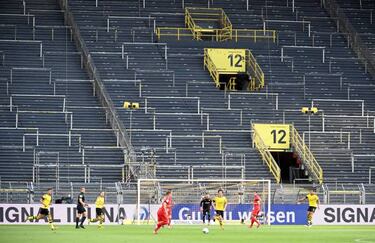The stats behind the Bundesliga’s return to action
German football recently returned behind-closed-doors after a two month break, we take a look at what impact the pandemic has had on the action on the pitch.


The Bundesliga became the first major football league to restart after the coronavirus-induced lockdown and will be viewed as a test case for Europe’s other top leagues. German sides have had to negotiate returning from a lengthy unplanned break; adhering to strict distancing measures for both players and staff; and playing games in empty stadiums for the remainder of the season.
These unprecedented measures will effect what we see on the pitch, and although we are only 27 games in it is possible to see trends in the way that these changes have shaped the game.

The home disadvantage disappears
One of the most long-standing trends in football is that teams tend to do better when playing at home than they do away. Data compiled by The Conversation found that across Europe’s top leagues since 2002, the home side is victorious in 46% of matches while the away side wins just 26%. This is usually put down to the familiarity that teams feel in their own ground and the boost they get from the home support.
With games currently being played behind closed doors both of these factors have been removed and the balance seems to have tipped in favour of the away side. Of the 27 games played since the Bundesliga resumed, the away side have won 12 and the home side just five. That means that the home team have only won in 19% of games.
The lack of fans is a key factor and may have affected Borussia Dortmund when they faced title rivals Bayern Munich on Tuesday. The Westfelstadion is one of the most intimidating venues in world football and could have made the difference in such a finely balanced fixture. However without 80,000 screaming Dortmund fans in attendance the Bavarians were able to close out the game fairly comfortably and duly picked up a 1-0 away win.

Teams struggling to find their shooting boots
In recent seasons the Bundesliga has gained a reputation as being one of the most exciting leagues in Europe and boasted the highest goals-per-game of any of the top five leagues for 2018/19. Last season each Bundesliga match had an average of 3.18 goals, comfortably higher than the Premier League’s 2.82 in second place.
Up until the season was stopped in March the Bundesliga was on course to beat that with an average of 3.25 goals per game but since the restart the goals have tailed off. The games since have seen an average of 3.07 goals, suggesting that players may have lost some of their match sharpness during the two month break. Even Robert Lewandowski, who still leads the scoring charts with a better than goal-a-game record this season, is yet to get off the mark in the three games so far. For older players like Lewandowski that mid-season break may have disrupted their usual rhythm and it may take them longer to return to full fitness.

Fewer goals, more thrashings
Even though there have been fewer goals scored since the Bundesliga returned, more teams are being comprehensively beaten than before the break. In the first 224 games of the 2019/20 season (up to the point when fixtures were suspended) there was a victory by at least three goals in 24% of them. However since then, 30% of games have ended with a margin of at least three goals. The increase in comfortable victories is particularly notable considering that none of the top three (Bayern, Dortmund and RB Leipzig) have played any of the bottom three (Dusseldorf, Werder Bremen and Paderborn).
But what has caused this trend? It could be that teams who go behind can no longer rely on their supporters to encourage them so the momentum of the game shifts too far in favour of the winning team. The crowd involvement that could spark a comeback or at least keep players motivated until the final whistle has been removed.
Related stories
Another factor could be clubs’ ability to deal with the upheaval caused by the pandemic. Of the eight three-goal victories since the Bundesliga returned, five have been won by the current top six and another two by the much-improved and comparatively wealthy Hertha Berlin. Sides with larger playing and coaching staffs will be better able to cope with the demands of playing twice a week after a long break and have been winning by larger margins.
For example in Bayern Munich’s 5-2 win over Eintracht Frankfurt last weekend, they were able to introduce German international Serge Gnabry from the bench to set up their fifth. With teams now able to make five substitutions per game, big clubs can really utilise their strength-in-depth to hammer home an advantage.